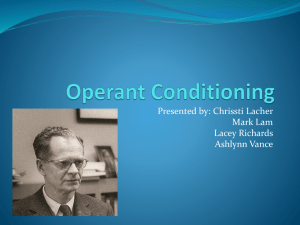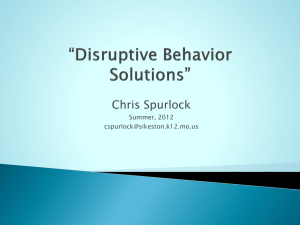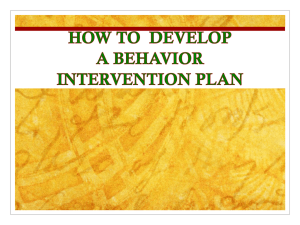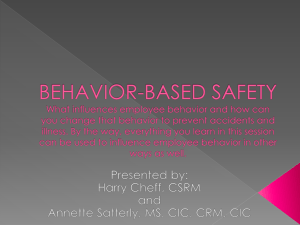Comprehensive Behavior Intervention Plan
advertisement
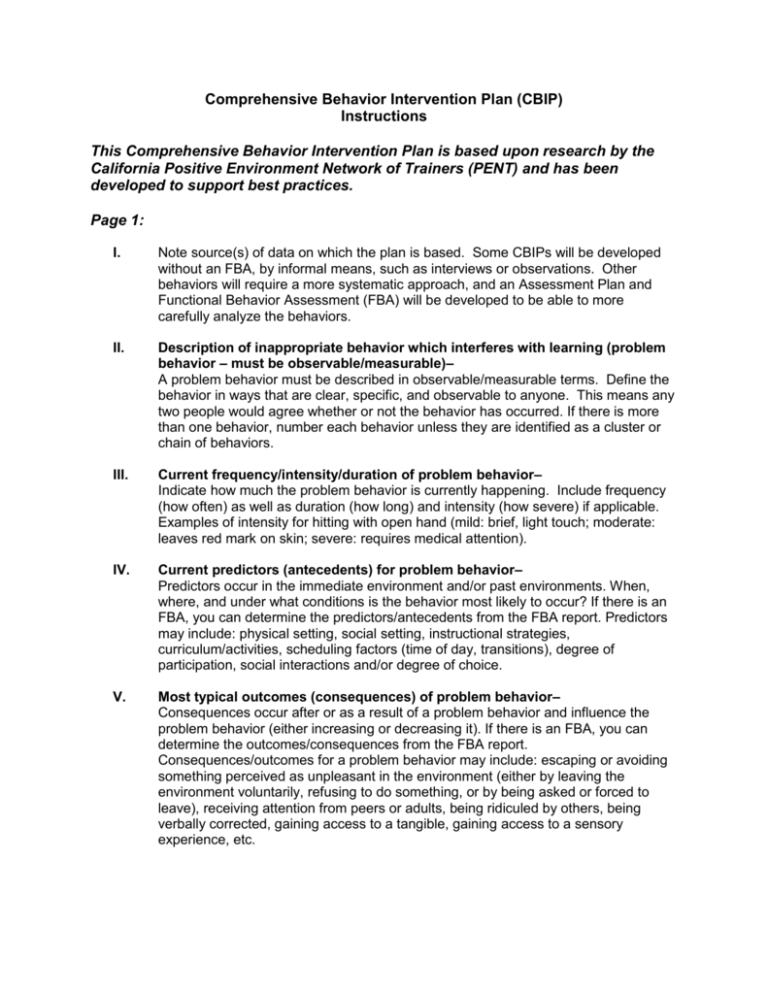
Comprehensive Behavior Intervention Plan (CBIP) Instructions This Comprehensive Behavior Intervention Plan is based upon research by the California Positive Environment Network of Trainers (PENT) and has been developed to support best practices. Page 1: I. Note source(s) of data on which the plan is based. Some CBIPs will be developed without an FBA, by informal means, such as interviews or observations. Other behaviors will require a more systematic approach, and an Assessment Plan and Functional Behavior Assessment (FBA) will be developed to be able to more carefully analyze the behaviors. II. Description of inappropriate behavior which interferes with learning (problem behavior – must be observable/measurable)– A problem behavior must be described in observable/measurable terms. Define the behavior in ways that are clear, specific, and observable to anyone. This means any two people would agree whether or not the behavior has occurred. If there is more than one behavior, number each behavior unless they are identified as a cluster or chain of behaviors. III. Current frequency/intensity/duration of problem behavior– Indicate how much the problem behavior is currently happening. Include frequency (how often) as well as duration (how long) and intensity (how severe) if applicable. Examples of intensity for hitting with open hand (mild: brief, light touch; moderate: leaves red mark on skin; severe: requires medical attention). IV. Current predictors (antecedents) for problem behavior– Predictors occur in the immediate environment and/or past environments. When, where, and under what conditions is the behavior most likely to occur? If there is an FBA, you can determine the predictors/antecedents from the FBA report. Predictors may include: physical setting, social setting, instructional strategies, curriculum/activities, scheduling factors (time of day, transitions), degree of participation, social interactions and/or degree of choice. V. Most typical outcomes (consequences) of problem behavior– Consequences occur after or as a result of a problem behavior and influence the problem behavior (either increasing or decreasing it). If there is an FBA, you can determine the outcomes/consequences from the FBA report. Consequences/outcomes for a problem behavior may include: escaping or avoiding something perceived as unpleasant in the environment (either by leaving the environment voluntarily, refusing to do something, or by being asked or forced to leave), receiving attention from peers or adults, being ridiculed by others, being verbally corrected, gaining access to a tangible, gaining access to a sensory experience, etc. VI. IEP Team believes behavior occurs because (hypothesis of function)– Based on FBA or team hypothesis, check the box that best summarized the function of the problem behavior, then describe what the student is trying to obtain, protest, or avoid by using this problem behavior. All problem behavior serves a function for the student. The behavior continues because it works to meet the student’s needs in some way. Almost all problem behavior occurs because the individual is trying to get something (an object, adult attention, peer attention, a privilege, etc.) or avoid something (certain tasks, transitions, people, challenging work, embarrassment, a threat to physical or emotional safety, etc). NOTE: – This is extremely critical because the replacement behavior needs to achieve the same outcome as the problem behavior. VII. Description of the positive/replacement behavior– Describe what student should do to gain the same outcome as the problem behavior in an acceptable way; NOT simply the absence of the problem behavior; should be something the student is capable of learning/doing). The replacement behavior (functionally equivalent replacement behavior: FERB) is a positive alternative that allows the student to obtain the same function the problem behavior provides in a manner that is acceptable in the environment. The FERB should maximize the benefits (e.g., more positive feedback from staff or peers) and minimize the cost to the student and others in the environment (e.g., loss of instructional time). NOTE: - The FERB must meet the same function as the problem behavior and be at least as easily performed as the problem behavior once it is learned. VIII. Current frequency of positive/replacement behavior– How often the student is currently using the positive replacement behavior. For some students this might not occur yet; others might be using the behavior infrequently, inappropriately, partially, in certain settings, or it might not be reinforced by staff. Page 2: IX. Teaching/Action Plan– The teaching/action plan describes the proactive interventions for the behavior plan and specific procedures and strategies for increasing the positive replacement behavior and decreasing the problem behavior. The page is divided into several sections and can be used as a staff sheet summarizing all the proactive components of the behavior plan. Interventions should include the responsible personnel and/or implementers of specific strategies. X. Reduction of problem behavior: A. Interventions– This section addresses changes in the environment that will prevent or reduce the need for the student to use the problem behavior. This may include environmental changes in how time is structured (e.g., reduced number of transitions, decreased demands), space is organized (e.g., preferential seating, increased access to teacher), materials are selected (e.g., behavior chart, visual schedule, curricular modifications), and/or positive interactions are increased (e.g., positive to negative feedback ratio, peer tutors, assigning tasks in the classroom). Indicate the frequency that interventions will be applied (avoid being general such as “as needed,” but indicate when; e.g., before a task is introduced, as student begins to get agitated); also indicate “Responsible Personnel” who are responsible for providing the interventions be specific; do not put general terms such as “IEP Team.” Describe who is to do what (e.g., is the teacher responsible to change the schedule, prompts, tone of instruction, materials or are paraeducators to provide interventions as well?). B. Reinforcement– In this section, the reinforcement procedures aimed at reducing the problem behavior are listed. Specify: What behavior(s) you are reinforcing (e.g., low rate of task refusal, participating in a recess without hitting or kicking another student) What the reinforcement is (e.g., verbal praise, social reinforcement, token, points on point sheet) The schedule of reinforcement (how often it is given) The criteria for delivering the reinforcer (what exactly the student has to do to gain access to the reinforcer) Responsible personnel (this could be different people, e.g., the teacher provides points on the point sheet, and the principal provides a daily reward when a certain number of points are earned). Elements to consider for reinforcement procedures: specific reinforcing items (tangible, activities, social reinforcement), immediacy (providing the reinforcer right after a target behavior), consistency (providing the reinforcer for each interval of lack of or low rates of Problem Behavior), choice (a variety of reinforcers), contingency (only given when the problem behavior does not occur) and effectiveness (e.g., the reinforcer has proven to be motivating for the student). C. Plan for fading interventions and reducing reinforcement for problem behavior– Specify target rate(s) for reduction in the occurrence of problem behavior, including period of time in which rate will be maintained (e.g. – “no more than two times a week for three weeks”). As those rate(s) are achieved, specify changes to be made in the interventions. These could include changes to be made in the ecology (e.g., reducing number of breaks; reducing physical supports such as study carrels or separate seating; reintroducing back into group activities), instructional strategies (e.g., reintroducing more demanding tasks; less intrusive prompts; less curricular modifications; reducing number of verbal prompts); and/or reinforcement schedule (e.g., lengthening reinforcement intervals, moving toward more intrinsic reinforcement). XI. Increase of positive/replacement behavior: A. Interventions– List specific strategies for teaching the positive/replacement behavior and other general positive behavior skills. These will vary depending on the behaviors you are teaching and the student. Specify the step-by-step procedures and materials you will need to teach the behaviors/skills, as well as the people who will teach them. Strategies should always be proactive and taught at planned intervals. Indicate frequency (e.g., daily, before a specific activity, during counseling or speech sessions); and responsible personnel (staff who will be responsible for teaching, modeling, eliciting the Positive/Replacement Behavior. Do not put “IEP Team,” instead, indicate specific staff responsible for creating or procuring any needed instructional materials creating reinforcement visuals, etc). B. Reinforcement– In this section, the reinforcement procedures aimed at increasing the positive/replacement behavior are listed. Specify: What positive/replacement behavior(s) you are reinforcing (e.g., asking for help instead of dropping to the floor, raising a hand for attention instead of shouting out, requesting a break instead of yelling/screaming) What the reinforcement is (e.g., verbal praise, social reinforcement, token, points on point sheet) The schedule of reinforcement (how often it is given) The criteria for delivering the reinforcer (what exactly the student has to do to gain access to the reinforcer) Responsible personnel (this could be different people, e.g., the paraeducator provides tokens on the token board, and the teacher provides a tangible reward paired with attention when a certain number of tokens are earned). Elements to consider for reinforcement procedures: specific reinforcing items (tangible, activities, social reinforcement), immediacy (providing the reinforcer right after the target behavior), consistency (providing the reinforcer for each interval in which the student engaged in the positive/replacement behavior), choice (a variety of reinforcers), contingency (only given when the Positive/Replacement behavior occurs) and effectiveness. C. Plan for fading interventions and reducing reinforcement for positive/replacement behavior: Specify target rates for increase in the rate of the Positive/Replacement Behavior. As that rate is achieved, specify changes to be made in the interventions (e.g., changing to intermittent reinforcement; increasing length of intervals; emphasizing more intrinsic reinforcement; fading artificial reinforcement in favor of more natural outcomes; giving less intrusive prompting; decreasing direct instruction and practice; allowing peers to step in to prompt/model rather than the teacher). Page 3: XII. Reactive strategies to employ/debrief procedures to use if the problem behavior occurs A. At precursor/first sign of problem behavior– Typically the first step in a reactive strategy is to prompt/remind the student to use the replacement behaviors to prevent the problem behavior from continuing or escalating. A prompt may be verbal, visual, gestural, etc. Further steps may also include: reminding the student of what they are working for, reminding of consequences to behaviors, encouraging choice-making, offering emotional or task support, etc. Indicate personnel who will do this (e.g., Some staff may be better at being less emotionally involved, others may prefer to do the re-directing). B. If problem behavior continues or escalates– This would be the next step in case the problem behavior continues or escalates. Specify how the staff will redirect the problem behavior and/or maintain the safety of everyone, e.g., escorting the student to a safe area, redirecting to a quiet space, removing the audience, planned ignoring, call for backup from support staff, etc. Indicate responsible personnel for various tasks – who removes student, who calls for help, who removes other students. C. Debriefing/follow up with staff and/or student if necessary– This follows the occurrence of a problem behavior and, depending on the student’s level of functioning, may include: a verbal dialogue, a written process, or a behavior practice session (e.g., practicing the replacement behavior, reading a social narrative, reviewing a picture sequence of the appropriate behavior steps). Indicate responsible personnel (e.g., Intensive School-Based Therapist may provide counseling after each incident, teacher will complete debriefing sheet with student, etc.). XIII. IEP Goals– There should be one goal to increase the Positive Replacement Behavior and one goal to either decrease Problem Behavior or to develop new general skills that remove the student’s need to use the Problem Behavior (e.g. If the problem behavior is getting out of the seat during an activity and running around the classroom, a general skill development goal would be to increase the student’s skills and strategies for attending to task). Every goal has to include all the elements required for IEP goals (see goal wizard or goal bank in SIRAS). Indicate the goal numbers that correlate. XIV. Communication– Active exchanges between all stakeholders and between home and school should be outlined and specified. It is important that all communication involves a two-way exchange rather than one person giving information to a passive recipient. Exchanges can occur through e-mail, phone calls, written logs, meetings, data collection sheets, point sheets, etc. Do not include the names of staff members to allow for changes in staffing. XV. Data Collection– Consider whether data collection is necessary in addition to data used to measure goals. For a behavior plan, data on problem and replacement behaviors should be collected on a regular basis to monitor progress, with method, frequency and personnel noted. In some cases, established data collection procedures are already part of the goals associated with the plan. In other cases, new or separate data collection procedures need to be established. XVI. Personnel Responsible for Monitoring Plan Implementation– Specify who will be responsible for monitoring and overseeing the implementation of the plan. The personnel will be determined based upon district policy, personnel training and qualifications, team decision, case manager assignment, etc.



